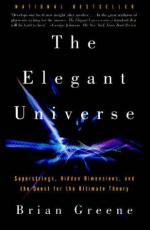
|
| Name: _________________________ | Period: ___________________ |
This test consists of 15 multiple choice questions and 5 short answer questions.
Multiple Choice Questions
1. Which of the follow best describes a boson?
(a) The supersymmetric version of a proton.
(b) A particle of energy, a messenger particle for a force.
(c) The super-partner of a proton.
(d) A particle of matter.
2. According to Newton's law of gravity, the strength of the pull between two objects depends on what factors?
(a) Their densities and the strength of the gravitational field they occupy.
(b) Their masses and potential energies.
(c) The distance between them and their average atomic numbers.
(d) Their masses and the distance between them.
3. Which of the following theory was NOT developed in order to try to resolve the conflicts between quantum mechanics and general relativity?
(a) Quantum field theory.
(b) Inflationary theory.
(c) Quantum electrodynamics.
(d) Superstring theory.
4. What is the photoelectric effect?
(a) Photons can spontaneously decay into electrons in powerful magnetic fields.
(b) When light shines on metals, the metals emit electrons.
(c) Electrons follow quantum paths made by photons.
(d) Electrons and photons only interact if they have the same frequency.
5. In Einstein's famous equation, E=mc^2, what does "c" represent?
(a) The speed of light.
(b) The object's density.
(c) The frequency of light.
(d) The speed of the object.
6. According to string theory, why do different particles have different properties?
(a) Their strings do not have the same number of dimensions.
(b) They have different types of strings.
(c) Their strings are vibrating in different patterns.
(d) Their strings are different lengths.
7. Which of the following best describes a fermion?
(a) The supersymmetric version of a proton.
(b) The super-partner of a proton.
(c) A particle of matter.
(d) A messenger particle for a force.
8. What is the Planck energy?
(a) The energy required to change a string's pattern.
(b) The typical energy of a messenger particle.
(c) The energy required to create a string.
(d) The typical energy of a vibrating string.
9. The first version of string theory did not include any particles of _____.
(a) Fermions.
(b) Messenger particles.
(c) Bosons.
(d) Gravitons.
10. Which of the following accurately describes the phenomenon of "quantum tunneling"?
(a) Particles with high energy can vanish in one location, instantly appearing in another.
(b) Some particles are linked together, no matter how much space separates them.
(c) Particles can sometimes "borrow" energy to move in ways impossible in classical physics.
(d) High-energy waves can penetrate the fabric of space-time for very short periods of time.
11. Which of the following correctly describes the structure of an atom?
(a) A cloud of neutrons orbiting a nucleus of other particles.
(b) A cloud of protons, each with an electron orbiting it.
(c) A cloud of electrons orbiting a dense nucleus.
(d) A single nucleus composed of both electrons and protons.
12. The wave-like nature of the electron means that after a collision, _____.
(a) The electron will disperse into a wave of energy.
(b) The electron has a range of possible locations.
(c) The electron can never be located again.
(d) The electron will double in frequency.
13. What characteristic did Werner Heisenberg discovered that some features of the universe at very small scales, and some properties of particle?
(a) They can change spontaneously, with no external influence.
(b) They always increase or decrease by certain increments.
(c) They cannot be known with complete precision.
(d) They are dependant on the velocity of the object being studied.
14. In which particle was spin first discovered?
(a) The photon.
(b) The proton.
(c) The electron.
(d) The neutron.
15. Which of the follow is true of objects with which string theory is concerned?
(a) The objects are purely imaginary.
(b) It concerns one-dimensional strings and nothing else.
(c) They include strings and other objects as well.
(d) They are all really Calabi-Yau shapes.
Short Answer Questions
1. What characteristic of the string determines the properties of the particle it represents?
2. Quantum chromodynamics concerns quantum mechanics and ____.
3. What property did the double-slit experiment demonstrate that light has?
4. What is different about a particle of antimatter, compared to its normal counterpart?
5. Which of the following was the first string theory?
|
This section contains 691 words (approx. 3 pages at 300 words per page) |

|




